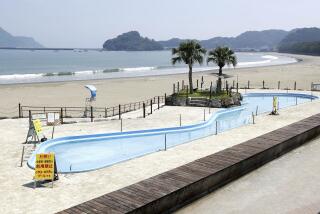In Japan, workers struggling to hook up power to Fukushima reactor
- Share via
Reporting from Tokyo and Morioka, Japan — Fighting exhaustion and radiation fears, engineers struggled anew Saturday to complete the crucial task of hooking up a damaged nuclear plant to the electricity grid to help cool damaged reactors. The official count of dead and missing in the quake and tsunami soared above 17,000, making this Japan’s worst disaster since World War II.
In the earthquake zone, tears trickled down the cheeks of some survivors and rescue workers as a solemn moment of silence was observed at 2:46 p.m. Friday, marking a week since the magnitude 9 temblor slammed Japan’s northeastern coast. The quake set off a chain of events culminating in the nuclear emergency now ranked as a 5 on the 7-point international scale.
Still unknown is whether restoring power to the damaged reactors will significantly aid cooling efforts. The full extent of damage to critical cooling pumps from hydrogen explosions and corrosion from seawater that has been pumped in has not been assessed.
Photos: Japan grapples with crisis
In what many considered an inevitable and perhaps tardy move, Japan’s nuclear regulatory agency Friday upgraded the severity of the still-unfolding disaster at Fukushima, 150 miles north of Tokyo, from a 4 to a 5 on the International Nuclear and Radiological Event Scale, meaning it is “an accident with wider consequences.”
The 1979 Three Mile Island incident in Pennsylvania, previously considered the second-worst accident in history, was rated a 5 -- and it did not cause injuries or a significant release of radiation. The Chernobyl nuclear accident in Ukraine was a 7 -- “a major accident” as defined by the scale.
The moment of silence was observed in three ravaged prefectures, or states, in the heart of the quake zone: Miyagi, Iwate and Fukushima, where hundreds of thousands of people remain displaced. Although the government pledged to accelerate relief efforts, hardship from hunger and cold remained rife.
Establishing a final toll will probably take weeks, but the National Police Agency said the official death count had reached 6,911, exceeding that of the 1995 Kobe earthquake, and the number of those unaccounted for stood at 10,754.
As of Saturday, about 300 workers were operating inside the 12-mile evacuation zone surrounding the battered nuclear plant, government and utility officials said. A nuclear safety official said their main objective was to attach power lines to two of the worst-hit reactors.
Other last-ditch measures are under discussion, however, including the drastic option of entombing the complex in concrete to stave off a large-scale leak of radiation.
Both the government and the plant’s operator, the Tokyo Electric Power Co., are on the defensive amid rising public anger over what many regard as an incomplete picture of events at the plant. On Friday, Prime Minister Naoto Kan said that the government has told the public everything about the accident at the plant. “[Chief Cabinet Secretary Yukio] Edano and I have been disclosing all of the information that we had,” he said.
Earlier, Kan pledged in a meeting with the head of the International Atomic Energy Agency, Yukiya Amano, to disclose as much information as possible about the unfolding nuclear crisis.
“The situation at the nuclear plant remains unpredictable,” Kan said in a nationally broadcast news conference. “We will definitely overcome this crisis. I want the people of this country to feel safe again.”
Amano has described the situation as “very grave and serious” but pointed out that, until now, an uncontrolled release of large amounts of radiation had been avoided and that there was little danger to public health outside the evacuation zone.
Reassurances were not enough to halt an exodus of foreigners, who continued to pack international airports and flights out. Many Japanese also are leaving the country, or seeking shelter with friends and relatives in southern cities considered safe.
Adding to Japan’s growing sense of isolation, the Food and Drug Administration in Washington said it would monitor foods imported from Japan for radiation exposure.
Nearly 1 million homes remain without electricity in the quake zone, and rolling blackouts have been taking place elsewhere. As the threat of blackouts has intensified, one activist called on Japan to unplug millions of vending machines that dispense items such as hot corn soup and bouquets of flowers.
Japan has 5.5 million vending machines, each using as much power as an average household, said Canadian speechwriter John Harris, who is based in Japan’s Chiba prefecture. Add that up, and it requires as much power as the entire capacity of the troubled Fukushima nuclear plant at a time when Japanese are being asked to conserve electricity, he said.
The nearly 1 million machines operated by Coca-Cola -- which because they use both refrigeration and heating are the “biggest power hogs” -- are still running even as train service is curtailed, he said.
[email protected]
[email protected]
Times staff writer Magnier reported from Morioka, Japan, and King reported from Tokyo. Hall, a special correspondent, contributed from Tokyo.
More to Read
Sign up for Essential California
The most important California stories and recommendations in your inbox every morning.
You may occasionally receive promotional content from the Los Angeles Times.










